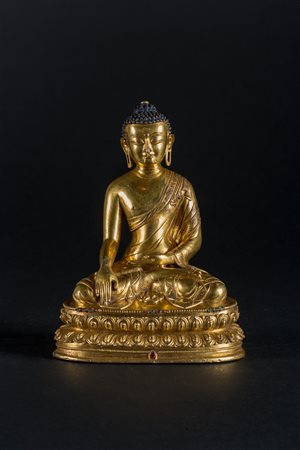 Capitolium Art - Via Carlo Cattaneo 55, 25121 Brescia
Capitolium Art - Via Carlo Cattaneo 55, 25121 Brescia
ASTA 210 - FINE CHINESE, ISLAMIC & ASIAN ART SECONDA SESSIONE
Friday 16 December 2016 hours 14:00 (UTC +01:00)
Arte Himalayana Statua di Buddha Sakyamuni in rame laminato in oro Tibet, XV...
Arte Himalayana Statua di Buddha Sakyamuni in rame laminato in oro
Tibet, XV - XVI secolo . -. Cm 15,00 x 20,00. Importante scultura raffigurante il Buddha storico nella sua canonica manifestazione. Il personaggio, dal volto ieratico e finemente realizzato, è seduto in padmasana su una base a doppio fiore di loto abbellita da gemme incastonate. La mano destra è nel gesto di prendere la terra a testimone della veridicità della sua parola (bhumisparsamudra), mentre la sinistra è adagiata in grembo in avakasamudra, il gesto di rilassamento. La figura indossa una veste monacale finemente cesellata ai bordi con decori fitomorfi. La base, ancora sigllata, mostra un doppio vajra, mentre sul retro della figura è presente una lunga iscrizione.
"L'iscrizione si riferisce alla propagazione della dottrina buddhista in relazione ai primi discepoli della cerchia del Buddha Sākyamuni, cui il committente si rivolge direttamente.
Traslitterazione dell'iscrizione con correzioni ortografiche fra parentesi:
°°|| Shag (per: Shā) kya thub pa khyed (per: khyed rang) kyi 'khor gi (per: gyi) thog ma
pu (per: bu)| chos dar skra bang ga||
Traduzione letterale delle parti leggibili dell'iscrizione:
(O) Sākyamuni, i primissimi (thog ma) figli (pu per: bu) della Vostra (khyed kyi) cerchia ('khor gyi),
propagazione (della) dottrina (chos dar) capelli (skra?) bang ga (bang ga).
L'iscrizione è costituita da sedici sillabe, alcune delle quali di significato incerto. Il testo potrebbe sottintendere un impianto iconografico in cui la statua era collocata centralmente in una serie di ritratti raffiguranti i primi discepoli di Sākyamuni."
Traduzione a cura del Professor Erberto Lo Bue
Arte Himalayana A gilt copper figure of Buddha Sakyamuni
Tibet, 15th - 16th century . . Cm 15,00 x 20,00. Noticeable sculpture depicting the Gautama Buddha, in his canonical manifestation. The figure, with a hieratic expression and finely made, is sitting in the padmasana position on a double lotus flower base, enriched by gems. The right hand performs the bhūmisparśa mudra, asking the earth to witness the truth of his word, while the left hand is resting in his lap in the avakasamudra, the gesture of relaxation. The figure wears a monastic robe, finely chiseled with phytomorphic decors on the edges. The base, still sealed, shows a double vajra, and at the back of the figure is a long inscription.
The inscription concerns the propagation of the Buddhist doctrine in relation to the first disciples of the following of Buddha Sakyamuni, here directly addressed.
Transliteration of the inscription with orthographic corrections in parenthesis:
°°|| Shag (for: Shā) kya thub pa khyed (for: khyed rang) kyi 'khor gi (for: gyi) thog ma
pu (for: bu)| chos dar skra bang ga||
Literal translation of the readable portions of the inscription:
(Oh) Sākyamuni, the first (thog ma) sons (pu per: bu) of your (khyed kyi) following ('khor gyi),
propagation (of the) doctrine (chos dar) hair (skra?) bang ga (bang ga).
The inscription is made up of sixteen syllables, some of which of uncertain meaning. The text might be in relation with an iconographical complex in which the sculpture was placed centrally, among a series of portraits depicting the first disciples of Sākyamuni.
Translation by Professor Erberto Lo Bue.





